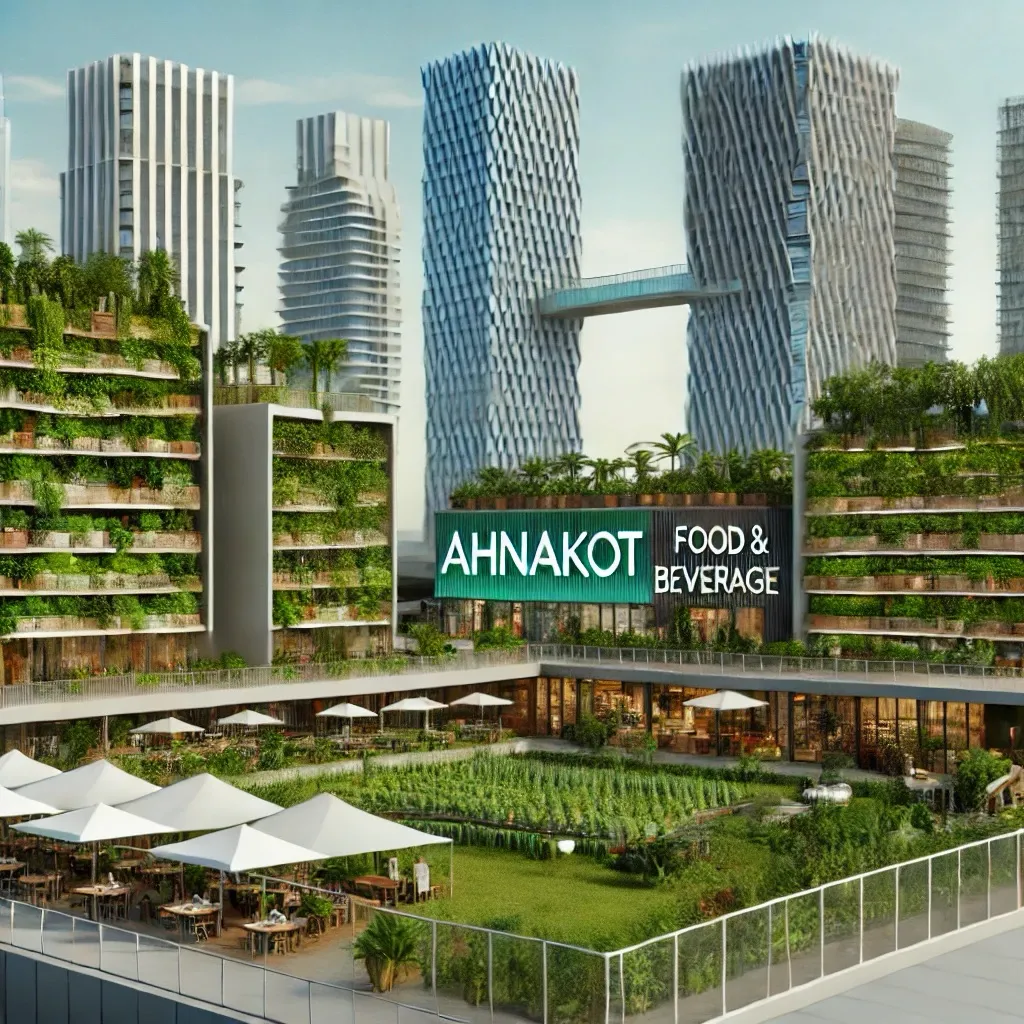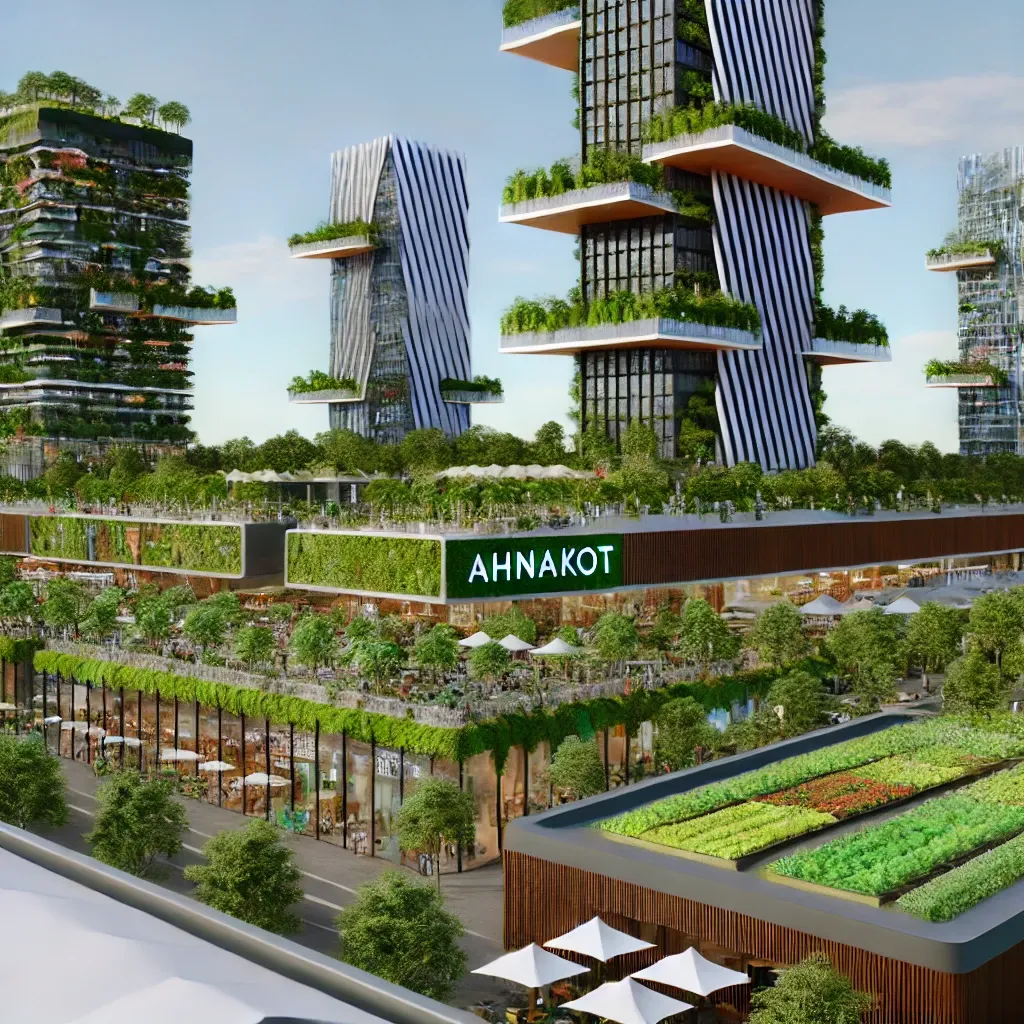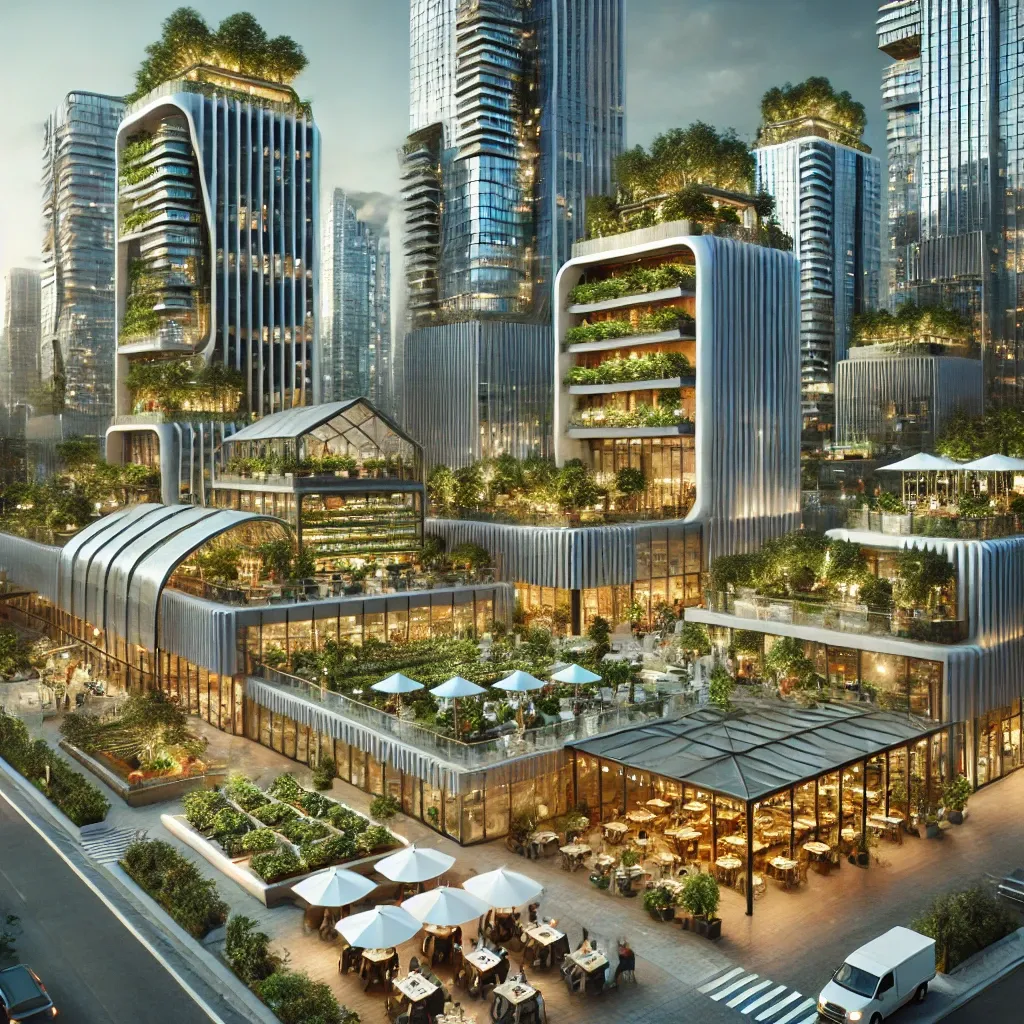AHNAKOT
Urban Agriculture and Food Security District
The **AHNAKOT Urban Agriculture and Food Security District** concept envisions a forwardthinking urban area that prioritizes sustainable food production, food security, and the integration of agriculture into the urban environment. This district is designed to be self-sufficient, reducing the carbon footprint associated with food transportation while providing fresh produce to its residents.
Key Features:Urban Agriculture and Food Security District
- Skyscraper Farms: Tall buildings in the district are dedicated to vertical farming, utilizing hydroponics, aeroponics, and other advanced agricultural technologies to grow a variety of crops year-round. These farms are energy-efficient and designed to maximize space utilization in the urban environment. urban environment.
- Greenhouses: High-tech greenhouses, integrated into buildings or as standalone structures, help to cultivate a diverse range of fruits, vegetables, and herbs. These greenhouses use renewable energy and water recycling systems to maintain optimal growing conditions.
- Rooftop Gardens: Rooftop spaces are transformed into community gardens, where residents can grow their own food, fostering a sense of community and engagement with sustainable practices.
- Urban Plots: Small plots of land scattered throughout the district are allocated for local residents and urban farmers to cultivate, providing fresh, locally-sourced produce.
- Aquaponics Systems: The district integrates aquaponics systems, combining fish farming with plant cultivation in a symbiotic environment. This system conserves water and provides both protein and vegetables in one cycle.
- Composting and Waste Management: Organic waste from the district is composted and returned to the soil, creating a closed-loop system that reduces waste and enhances soil fertility.
- Agricultural Research Centers: Facilities dedicated to research in sustainable agriculture and food security are a central part of the district. These centers collaborate with universities and global experts to develop new farming techniques and educate the community.
- Workshops and Training Programs: Regular workshops and training sessions are offered to residents and urban farmers, teaching them about sustainable agriculture practices, food preservation, and the importance of food security.
Local Markets: The district hosts farmers' markets where residents can buy and sell fresh produce. These markets are a hub for local food commerce and community interaction.
Food Distribution Centers: Centrally located food hubs ensure that produce grown within the district is efficiently distributed to residents, with surplus being stored or donated to nearby areas.
- Green Spaces: The district features numerous parks, green belts, and water features that not only enhance the aesthetic appeal but also support urban biodiversity.
- Pollinator-Friendly Gardens: Gardens and green spaces are designed to attract pollinators, such as bees and butterflies, which are essential for maintaining healthy crops and supporting the broader ecosystem.
- The images that can be created for the AHNAKOT Urban Agriculture and Food Security District will depict a vibrant urban area where agriculture is seamlessly integrated into the cityscape. Expect to see towering vertical farms, rooftop gardens, lush greenhouses, and bustling local markets, all framed by the backdrop of a modern, eco-friendly urban environment. The visuals will capture the essence of a self-sustaining community that thrives on innovation, sustainability, and a close connection to nature.
Discover what’s possible with Understood
Project Portal Link
-
PROJECT SECTOR 1
- 1.Affordable Housing District
- 2.African Harbor District
- 3.Agricultural and Food Production District
- 4.Agriculture and Livestock District
- 5.AIRPORT
- 6.Arabic Harbor District
- 7. AREYATHOR KHMER District
- 8.Buddhism Park History
- 9.Cambodian Historical and Cultural Museum
- 10.CENTRAL BUSINESS DISTRICT (CBD)
- 11.Christian Park History
- 12.City-Wide Integration and Features
- 13.Cultural and Arts District
- 14.Digital and Communications District
- 15.Education and Knowledge District
- 16.Entertainment and Media District
- 17.Environmental Education and Awareness District
-
PROJECT SECTOR 2
- 18.Environmental Research and Development District
- 19.Environmental Conservation District
- 20.Financial District
- 21.French Harbor District
- 22.Government and Administrative District
- 23.Greek Harbor District
- 24.Green Energy and Sustainability District
- 25.Health and Wellness District
- 26.HINDUISM PARK HISTORY
- 27.Historical and Heritage District
- 28.Innovation and Research District
- 29.Islamic History Park
- 31.Japanese Harbor District
- 32.Judaism Park History
- 33.Khmer Harbor District
- 34.Lake Tower District
- 35.Luxury Residential District
-
PROJECT SECTOR 3
- 36.MARINA DISTRICT
- 37.Mexican Harbor District
- 38.Museum Of The Future
- 39.Portuguese Harbor District
- 40.Public Services and Infrastructure District
- 41.Residential Districts
- 42.Retail and Commerce District
- 43.Smart Industrial and Manufacturing District
- 44.Smart Mobility and Transportation District
- 45.Smart Technology and AI District
- 46.Sports and Recreation District
- 47.Tech and Innovation District
- 48.Tourism and Hospitality District
- 49.Transport and Logistics District
- 50.Urban Agriculture and Food Security District V
- 51.Urban Design and Architecture District
- 52.Waterfront District
Project Portal Link
-
PROJECT SECTOR 1
- 1.Affordable Housing District
- 2.African Harbor District
- 3.Agricultural and Food Production District
- 4.Agriculture and Livestock District
- 5.AIRPORT
- 6.Arabic Harbor District
- 7. AREYATHOR KHMER District
- 8.Buddhism Park History
- 9.Cambodian Historical and Cultural Museum
- 10.CENTRAL BUSINESS DISTRICT (CBD)
- 11.Christian Park History
- 12.City-Wide Integration and Features
- 13.Cultural and Arts District
- 14.Digital and Communications District
- 15.Education and Knowledge District
- 16.Entertainment and Media District
- 17.Environmental Education and Awareness District
-
PROJECT SECTOR 2
- 18.Environmental Research and Development District
- 19.Environmental Conservation District
- 20.Financial District
- 21.French Harbor District
- 22.Government and Administrative District
- 23.Greek Harbor District
- 24.Green Energy and Sustainability District
- 25.Health and Wellness District
- 26.HINDUISM PARK HISTORY
- 27.Historical and Heritage District
- 28.Innovation and Research District
- 29.Islamic History Park
- 31.Japanese Harbor District
- 32.Judaism Park History
- 33.Khmer Harbor District
- 34.Lake Tower District
- 35.Luxury Residential District
-
PROJECT SECTOR 3
- 36.MARINA DISTRICT
- 37.Mexican Harbor District
- 38.Museum Of The Future
- 39.Portuguese Harbor District
- 40.Public Services and Infrastructure District
- 41.Residential Districts
- 42.Retail and Commerce District
- 43.Smart Industrial and Manufacturing District
- 44.Smart Mobility and Transportation District
- 45.Smart Technology and AI District
- 46.Sports and Recreation District
- 47.Tech and Innovation District
- 48.Tourism and Hospitality District
- 49.Transport and Logistics District
- 50.Urban Agriculture and Food Security District V
- 51.Urban Design and Architecture District
- 52.Waterfront District







